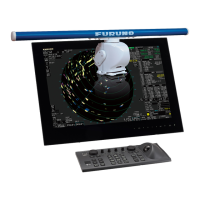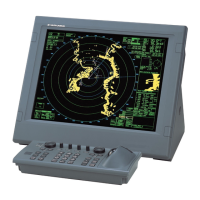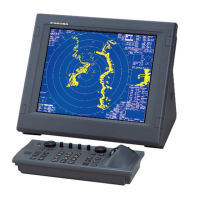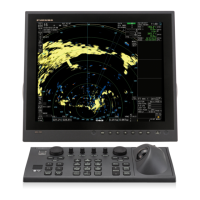Do you have a question about the Furuno FAR-2338S and is the answer not in the manual?
Identifies the document as an operator's manual for marine radar systems.
Lists critical safety precautions for operating and maintaining the radar equipment.
Warns about hazards related to the rotating antenna and water ingress into equipment.
Provides an overview of the controls available on the RCU-014 and RCU-015/RCU-016 control units.
Explains the procedure for powering the radar system on and off using the control unit.
Details how to adjust screen brilliance using both the control unit and on-screen menus.
Explains the different areas of the radar display and available shortcuts for various functions.
Describes the information and settings areas on the radar display, including date/time and own ship data.
Explains how to use the cursor menu for activating and controlling various radar functions like EBL offset and zoom.
Details how to assign specific radar functions to the F1-F4 keys for quick, one-touch access.
Guides users on how to customize various operational settings of the radar system to suit their needs.
Describes methods for entering own ship's speed, including automatic input from logs or EPFS, and manual input.
Guides users on selecting the data source for the own ship's position, such as EPFS, LAN, ECDIS, or dead reckoning.
Describes the procedures for starting and stopping radar transmission (TX) and managing antenna rotation.
Explains how to adjust the radar receiver's sensitivity (gain) for optimal target visibility and noise reduction.
Details how to select between automatic (AUTO) or manual (MAN) modes for sea clutter reduction.
Explains how to fine-tune the A/C SEA circuit for optimal sea clutter reduction using auto or manual settings.
Guides on how to manually adjust the AC/SEA control to reduce sea clutter effectively.
Guides on selecting between automatic (AUTO) or manual (MAN) methods for rain clutter reduction.
Details how to manually adjust the A/C RAIN control to reduce rain clutter and improve target recognition.
Explains how to use the interference rejector feature to reduce mutual radar interference and improve display clarity.
Explains the echo averaging feature for reducing sea clutter and improving target discrimination by averaging echoes over successive frames.
Details the two methods for activating or deactivating the ACE function for automatic clutter elimination.
Explains how to adjust the radar gain while the ACE function is active for optimal performance.
Describes how to use the noise rejector to reduce white noise and improve the screen's signal-to-noise ratio.
Explains how to enable or disable the second-trace echo rejection feature to prevent false echoes from distant targets.
Guides on how to select the radar's range scale and range ring interval for optimal target viewing.
Details how to use the Variable Range Marker (VRM) to accurately measure the range to targets.
Guides on using the offset EBL to assess the risk of collision by measuring range and bearing between targets.
Details the procedure for measuring range and bearing between two targets using EBL and VRM with the CURSOR menu.
Describes how to display echo trails in true or relative motion to track target movements.
Details the procedure for activating or deactivating the target analyzer function and enabling rain echo hatching.
Guides on setting alarm zones to alert navigators to targets entering specific areas.
Details how to activate or deactivate the performance monitor and display its graph.
Explains how to check the radar's performance by setting the number of arcs on the display.
Defines what an alert is, its priority levels (ALARM, WARNING, CAUTION), and categories (A, B, C).
Details procedures for formatting, inserting, removing, saving, and deleting data on the SD card.
Guides on the initial setup required in the [RADAR INSTALLATION] menu to enable the dual radar display.
Explains how to switch control between the own and external radars in a dual radar setup.
Details operational considerations and differences when using the dual radar display.
Describes multiple echoes, sidelobe echoes, virtual images, shadow sectors, their causes and reduction methods.
Details how a SART is triggered and how its response appears on the radar display, including distant and close signals.
Provides crucial warnings and cautions regarding the use of target tracking and its accuracy limitations.
Guides on selecting the TT acquisition mode (manual, automatic, or combined) and setting up acquisition parameters.
Explains the procedure for manually acquiring targets using either the control unit or trackball module.
Guides on setting the CPA and TCPA ranges to configure collision alarms for threatening targets.
Guides on enabling acquisition zones for automatic target alerting and acquisition.
Details procedures for activating the first acquisition zone (AZ1) and setting polygon acquisition zones (AZ2).
Describes the two types of trial maneuvers (dynamic and static) used to simulate ship movements against targets.
Details the procedure for setting up and performing trial maneuvers, including speed, course, and delay time.
Details the AIS object storage buffer capacity, alerts for full buffer, and processing/display capacities.
Guides on activating sleeping AIS targets and sleeping activated targets to focus on important ones.
Explains how to set a filter for AIS lost alerts to classify objects and enable/disable the lost alert function.
Explains how the radar calculates CPA and TCPA to provide AIS collision alarms for dangerous targets.
Guides on using the association function to present a single symbol for the same physical target detected by both AIS and TT.
Describes the six available orientation modes for the radar display, including True Motion.
Details how to show/hide radar map marks, select mark colors, inscribe marks, and delete them.
Details how to show/hide tracks, set plotting intervals, set track colors, and automatically plot target tracks.
Guides on setting data sources for waypoints, entering/editing waypoints, erasing them, displaying waypoint lists, and managing routes.
Explains how to show/hide charts, align chart position, select chart types, and configure chart settings.
Provides a schedule for regular maintenance checks and measures to ensure optimal performance and longevity.
Details the procedure for replacing fuses in AC and DC powered configurations, emphasizing correct fuse usage.
Offers simple troubleshooting steps for common problems like picture freeze, no display, or incorrect indications.
Describes troubleshooting procedures for hardware and software issues that require qualified service personnel.
Guides on executing the diagnostic test program to check major circuit boards in the control unit, processor unit, and card I/F unit.
Identifies the document as an operator's manual for marine radar systems.
Lists critical safety precautions for operating and maintaining the radar equipment.
Warns about hazards related to the rotating antenna and water ingress into equipment.
Provides an overview of the controls available on the RCU-014 and RCU-015/RCU-016 control units.
Explains the procedure for powering the radar system on and off using the control unit.
Details how to adjust screen brilliance using both the control unit and on-screen menus.
Explains the different areas of the radar display and available shortcuts for various functions.
Describes the information and settings areas on the radar display, including date/time and own ship data.
Explains how to use the cursor menu for activating and controlling various radar functions like EBL offset and zoom.
Details how to assign specific radar functions to the F1-F4 keys for quick, one-touch access.
Guides users on how to customize various operational settings of the radar system to suit their needs.
Describes methods for entering own ship's speed, including automatic input from logs or EPFS, and manual input.
Guides users on selecting the data source for the own ship's position, such as EPFS, LAN, ECDIS, or dead reckoning.
Describes the procedures for starting and stopping radar transmission (TX) and managing antenna rotation.
Explains how to adjust the radar receiver's sensitivity (gain) for optimal target visibility and noise reduction.
Details how to select between automatic (AUTO) or manual (MAN) modes for sea clutter reduction.
Explains how to fine-tune the A/C SEA circuit for optimal sea clutter reduction using auto or manual settings.
Guides on how to manually adjust the AC/SEA control to reduce sea clutter effectively.
Guides on selecting between automatic (AUTO) or manual (MAN) methods for rain clutter reduction.
Details how to manually adjust the A/C RAIN control to reduce rain clutter and improve target recognition.
Explains how to use the interference rejector feature to reduce mutual radar interference and improve display clarity.
Explains the echo averaging feature for reducing sea clutter and improving target discrimination by averaging echoes over successive frames.
Details the two methods for activating or deactivating the ACE function for automatic clutter elimination.
Explains how to adjust the radar gain while the ACE function is active for optimal performance.
Describes how to use the noise rejector to reduce white noise and improve the screen's signal-to-noise ratio.
Explains how to enable or disable the second-trace echo rejection feature to prevent false echoes from distant targets.
Guides on how to select the radar's range scale and range ring interval for optimal target viewing.
Details how to use the Variable Range Marker (VRM) to accurately measure the range to targets.
Guides on using the offset EBL to assess the risk of collision by measuring range and bearing between targets.
Details the procedure for measuring range and bearing between two targets using EBL and VRM with the CURSOR menu.
Describes how to display echo trails in true or relative motion to track target movements.
Details the procedure for activating or deactivating the target analyzer function and enabling rain echo hatching.
Guides on setting alarm zones to alert navigators to targets entering specific areas.
Details how to activate or deactivate the performance monitor and display its graph.
Explains how to check the radar's performance by setting the number of arcs on the display.
Defines what an alert is, its priority levels (ALARM, WARNING, CAUTION), and categories (A, B, C).
Details procedures for formatting, inserting, removing, saving, and deleting data on the SD card.
Guides on the initial setup required in the [RADAR INSTALLATION] menu to enable the dual radar display.
Explains how to switch control between the own and external radars in a dual radar setup.
Details operational considerations and differences when using the dual radar display.
Describes multiple echoes, sidelobe echoes, virtual images, shadow sectors, their causes and reduction methods.
Details how a SART is triggered and how its response appears on the radar display, including distant and close signals.
Provides crucial warnings and cautions regarding the use of target tracking and its accuracy limitations.
Guides on selecting the TT acquisition mode (manual, automatic, or combined) and setting up acquisition parameters.
Explains the procedure for manually acquiring targets using either the control unit or trackball module.
Guides on setting the CPA and TCPA ranges to configure collision alarms for threatening targets.
Guides on enabling acquisition zones for automatic target alerting and acquisition.
Details procedures for activating the first acquisition zone (AZ1) and setting polygon acquisition zones (AZ2).
Describes the two types of trial maneuvers (dynamic and static) used to simulate ship movements against targets.
Details the procedure for setting up and performing trial maneuvers, including speed, course, and delay time.
Details the AIS object storage buffer capacity, alerts for full buffer, and processing/display capacities.
Guides on activating sleeping AIS targets and sleeping activated targets to focus on important ones.
Explains how to set a filter for AIS lost alerts to classify objects and enable/disable the lost alert function.
Explains how the radar calculates CPA and TCPA to provide AIS collision alarms for dangerous targets.
Guides on using the association function to present a single symbol for the same physical target detected by both AIS and TT.
Describes the six available orientation modes for the radar display, including True Motion.
Details how to show/hide radar map marks, select mark colors, inscribe marks, and delete them.
Details how to show/hide tracks, set plotting intervals, set track colors, and automatically plot target tracks.
Guides on setting data sources for waypoints, entering/editing waypoints, erasing them, displaying waypoint lists, and managing routes.
Explains how to show/hide charts, align chart position, select chart types, and configure chart settings.
Provides a schedule for regular maintenance checks and measures to ensure optimal performance and longevity.
Details the procedure for replacing fuses in AC and DC powered configurations, emphasizing correct fuse usage.
Offers simple troubleshooting steps for common problems like picture freeze, no display, or incorrect indications.
Describes troubleshooting procedures for hardware and software issues that require qualified service personnel.
Guides on executing the diagnostic test program to check major circuit boards in the control unit, processor unit, and card I/F unit.
| Range Scales | 0.125 to 96 NM |
|---|---|
| Antenna Type | Open Array |
| Display | Color LCD |
| Power Supply | 24 V DC |
| Type | Marine Radar |
| Frequency | 9.41 GHz |
| Antenna Length | 8 feet |
| Beamwidth | 1.2° (horizontal) |
| Rotation Speed | 24 RPM |











